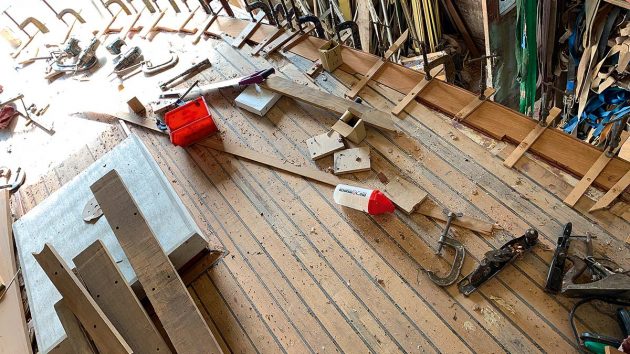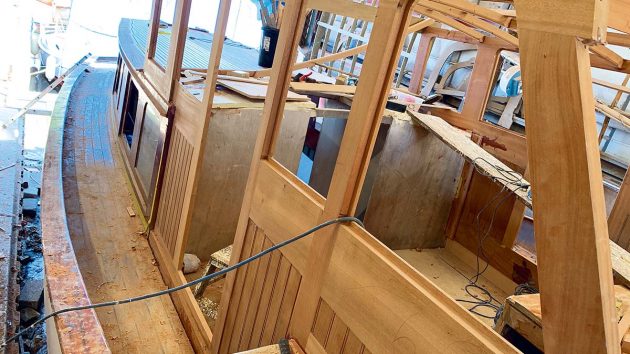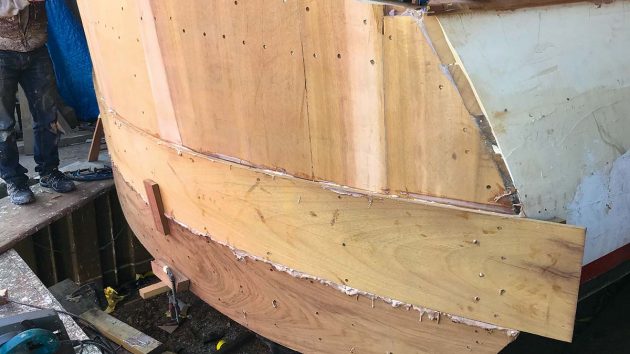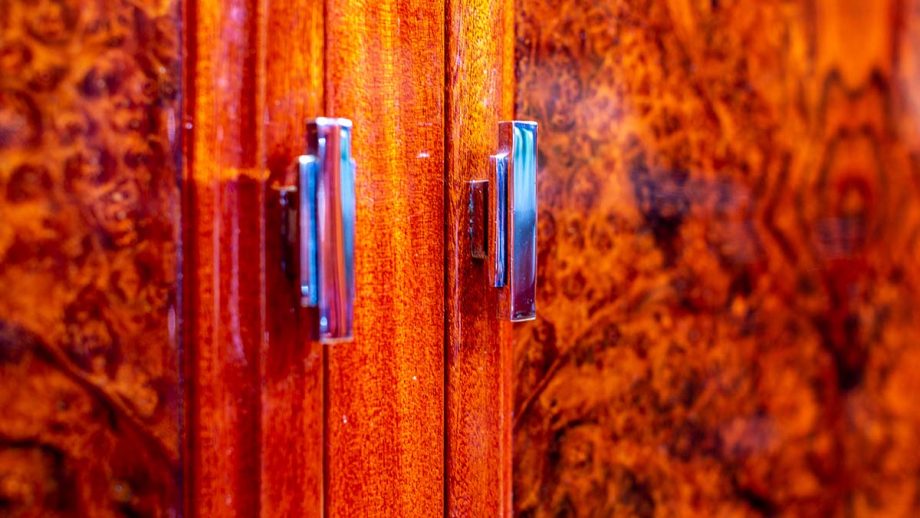Desperate to impress his dismissive father, Alain Lamens sold his house to restore this stunning Dunkirk Little Ship…
The 2014 Southampton Boat Show glowed with a dazzling array of polished fibre-glass hulls glinting in the sunlight. From the latest sleek sportscruisers to towering gin palaces and even a superyacht or two, it was enough to make even a budding oligarch drool.
But incredible as these modern wonders were, none of them grabbed my attention as much as a 113-year-old gentleman’s motor launch called Wise Folly. It was being exhibited by Dennett Boat Builders after a full restoration by the company’s craftsmen. I had no inkling that meeting them would be the start of a life-changing adventure.
The reason Wise Folly had caught my eye was because I’d come to the show to look for inspiration and advice on how to restore my own classic boat at the time, Little Ann II.
She had been built in 1946 by William Osborne and was a 26ft Swift Junior class design. Unfortunately Little Ann had developed dry rot in the hull above the waterline and leaks in the roof and superstructure.
At the time, I knew very little about wooden boats. Little Ann had been, if not an impulse buy, certainly a rash and rushed purchase. I had decided that I wanted to propose to my husband-to-be on a boat. But not just any old boat; my own boat.
Despite having had little experience at sea, I have been attracted to boats since I was a child. One of my earliest memories is of taking the helm of a little wooden speedboat on holiday in Italy.
Article continues below…

Cockwells boat yard owner reveals his Dunkirk Little Ship restoration

Dunkirk Little Ship restoration: The amazing story of a boat that survived both World Wars
I still remember the feeling of pride and excitement of being at the helm, a feeling I was desperate to rekindle. I approached the Dennett stand and got chatting to David Cherrett. I explained that I wasn’t looking to buy Wise Folly but was looking for inspiration to restore my own boat.
He offered me a cup of tea, and despite not really liking tea (I am Belgian by birth), I accepted because it was an opportunity to pick his brains while trying to decide if they were the right people to carry out Little Ann II’s restoration.
Spurred on by my determination to propose on the boat – under Tower Bridge was my plan – I soon decided they were the team I needed. The project would be supervised by Stephen Dennett himself.
Being curious by nature, I couldn’t resist popping down to the Dennett boatyard in Chertsey to check on the progress on weekends. It wasn’t long before Steve noticed my enthusiasm and, thrusting a tool into my hands, set me to work on Little Ann myself.
As an amateur, it took me a lot of hard work to achieve anything like the results the professionals around me managed with apparent ease, but I was grateful for the opportunity to observe and learn from them.
Father figures
Learning a new craft is always a thrill and I wasted no time in telling my family. But while I am naturally gregarious, my father had always been a man of few words.
Praise of any kind was sparse so when I excitedly explained that Little Ann II was a 1946 rebuild of the original Little Ann, which had been lost in the war, his response was less than enthusiastic. “So, it’s not a historic boat then. And it’s made of wood. You may as well throw £50 notes into the river!” he cautioned.
Up to a point, he was right – these boats are costly to maintain – but what he didn’t appreciate is that the peace and contentment I feel when I’m on the water is priceless.
But his words still nagged at me. No matter how old one gets, a son still craves the approval of his father. And I desperately wanted it. I decided that the answer was not to give up boating – that would be unimaginable – but to find a boat with real history and a story that would impress even my father.
Boats like this are notorious for requiring a great deal of work but the restoration undertaken of Little Ann had proved such a positive experience that I relished the challenge, especially if Dennett agreed to undertake another project with me. All that was needed was a boat worthy of the work and expense…

How Breda looked when Alain first set eyes on her
Dunkirk survivor
Then, in the summer of 2017, we found her. Breda, a bona fide Dunkirk Little Ship, was in a terrible state. She was rotting away at her mooring on the Thames, unloved and taking on rain water. In her time she’d rescued so many but now she was in need of rescuing.
Originally named Dab II, she was designed and built in 1931 by J W Brooke & Co of Oulton Broad, Norfolk for George Smart of Westcliff-on-Sea. By the outbreak of war in 1939 she was owned by a Colonel Hardy.
When the Colonel discovered that the Royal Navy had commandeered his motor yacht for use in Operation Dynamo – the heroic effort to rescue troops stranded on the beaches of Dunkirk – he was outraged. Not because they had taken his yacht but because he had not been given the chance to go along with her!

Although Breda made it to Dennetts on her own bottom she was not in a good state
Instead, she was captained by Lieut R.W. Thompson and crossed the Channel an impressive three times in six days. On the final return journey, she rescued a group of Dutch soldiers from Breda in the Netherlands. They had fought a gallant rearguard action on the retreat to Dunkirk, driven by the weight of the German advance.
When Colonel Hardy was finally reunited with his yacht at the end of the war, he renamed her Breda in honour of the soldiers she saved on that final voyage. This was a boat with a pedigree and a history not even my father could fault, even if it meant a lot more £50 notes leaving my wallet!
I bought her in October 2017 but didn’t tell my dad at the time as I wanted to surprise him once the restoration was complete. Thankfully, Stephen Dennett was as excited as I was and agreed to take it on. It was the start of a three-year adventure.

35 planks and 53 ribs had to be replaced to make her hull and topsides secure again
Work begins
By December, Breda was on their slipway ready for inspection. It was soon apparent that a major overhaul would be necessary, including urgent repairs to her hull, before she was seaworthy again.
It wasn’t just the few planks and a hull paint I was hoping for, so the boatyard worked with me to establish a scope and timeline to suit my budget, and once again gave me the opportunity to work on the boat myself under their guidance as my time permitted.
It had to be carefully planned and timetabled. As hoped, I proposed to my boyfriend Michael aboard Little Ann II and was delighted when he accepted. We intended to get married in the summer of 2018 so we had to work everything around that.

Dennett’s craftsmen used all their skills to bring Breda back
A summary of the work required included replacing 19 ribs, 18 planks and 15 deck beams on the starboard side; 34 ribs, 17 planks and 15 deck beams port side; gunwale and beam shelves on both sides; a full aft cabin rebuild and transom replacement.
This was a much bigger project than I had initially imagined and I needed to find further funding, not only to ensure the boatyard was always paid on time, phase by phase, but also because if I was to do Breda justice – and make her comfortable, practical, safe and future proof for navigating at sea – it would require considerable investment.
As well as the hull restoration, I also needed to budget for appliances like an ice cube maker and wine fridge, and bespoke top-of-the-range mattresses. And of course the latest navigation electronics. All of this would have to be powered by a state-of-the-art power system. This was the only way Breda would be able to be enjoyed for generations to come.

30 deck beams also needed replacing before the deck could be relaid and the new wheelhouse added
So at the start of 2018 I decided to go all in! I sold my small London property to fund the project in its entirety. Obviously, I didn’t dare tell my father, rather I hoped the end result would speak for itself.
By April 2018, with vital hull repairs complete, Breda was put back in the water to make way for the usual summer rush of boats needing immediate attention at the yard. Meanwhile, work continued on her engines and fuel systems so she could be lifted back onto the slipway over winter where her interior rebuild would begin.
During the summer, Parker Marine Services came and emptied the four diesel tanks totalling 900 litres so the fuel could be polished, the tanks cleaned and the hoses, seals and senders replaced.

New oil and fuel filters had to be sourced as the original parts for the two Ford Sabre 135hp six-cylinder engines were no longer available. Once these were installed and the injectors cleaned, the two blue monsters were soon purring contentedly again.
Other summer work included removing all the bronze items so they could be polished and chromed by Andrew Burt at Antique Metal Restorations in Chobham. The metal stanchions were also removed, sandblasted and repainted.
Finally, keen to not lose any of my recently acquired varnishing skills, I kept my hand in by personally restoring and varnishing a little desk seat that we discovered inside Breda.

The new wheelhouse had to be rebuilt from scratch to suit her original 1930s styling
It was looking very sad and abandoned in a corner, with old maritime charts still inside it. However, with a bit of elbow grease, I soon had it looking much happier and ready to go back on board.
Design for life
Winter saw the start of the second phase of the restoration. The major part of this would be the redesign of the forward spaces. I wanted the interior of the boat to reflect its Art Deco origins, with plenty of period-appropriate fixtures and fittings.
But first there were more structural tasks to take care of. All 151 of the original teak planks on the foredeck were removed, numbered, documented and restored ready for refitting. By October the new beam shelves had also been installed and the entire hull stripped back to bare wood, ready to be undercoated, primed and repainted.

The rotten transom also had to be stripped and rebuilt while Breda was out of the water
In November we secured the deck beams and made them ready to receive the tongue-and-groove ceiling. Lastly, we added two layers of marine ply and an epoxy sheathing over the entire structure, making it weatherproof for decades to come.
The new year heralded the start of another phase in the project, the Art Deco-inspired interior. Heather Dennett had taken my complex specifications and translated them into a sumptuous design, which her team of skilled carpenters and finishers could begin to create.
Heather’s design made subtle changes to my initial ideas to allow for more practical movement around the boat. She explained how a central corridor would be important to move quickly around the ship when under way and advised a more symmetrical layout with a centre aisle. I agreed.

Having subsequently taken Breda across the English Channel in some challenging weather conditions, I’m glad I did. Luckily none of these practical changes meant I had to give up on the espresso bar or the ice-cube maker!
Breda may have been pressed into wartime service in her early days – a role she played with distinction – but in her old age she would be returning to her original role as a gentleman’s pleasure yacht.
This meant comfortable living quarters for us and our guests. Forward, just behind the anchor chain locker would be a wet room with a rain shower and period fittings. This would lead into the guest cabin with two berths and ample storage space.

The new mahogany wheelhouse structure before the roof and glazing were added
Next would be the owner’s cabin, with a double berth panelled in varnished walnut and a vanity desk in mahogany and burr walnut. Throughout, antiqued mirrors would create the illusion of a bigger space.
Each berth was fitted with headboards composed of mahogany, burr maple, and burr walnut inserts arranged in an Art Deco fan shape, edged with polished metal borders. A round chest of drawers would offer plenty of storage and the bedside table would contain discrete technology, allowing us to charge a mobile phone wirelessly.
The clever design balanced the appearance of 1930s style and luxury with the convenience of modern equipment in a seamless integration.

Once weatherproof, the focus switched to fitting out the interior of the wheelhouse
Wheelhouse reinvention
In June 2019, the final phase began: rebuilding the wheelhouse. This was remade from scratch out of mahogany, conforming to the original dimensions. The only modification we made was to enlarge the sunroof to allow for easy removal of the engines if we ever needed to replace them in the future.
June was chiefly devoted to varnishing the forward areas and the main structure. So was July. And August. To this day, the first question most visitors ask is: “How many coats of varnish did this take?” To be honest, I lost count.
Varnishing complete, Dennett’s carpenters could begin to fit out the galley and saloon with two bars, which they built chiefly of mahogany and burr walnut. The floors were English oak with deco-style mahogany inlays.

The original helm was a pretty basic affair so Dennetts recreated a new one using traditional analogue dials but modern electronics. Alain did much of the wiring himself
In September we began installing her complex electrical and navigational equipment as well as her new batteries and power management systems.
I personally spent five months laying over a mile of Oceanflex 12V cable, and then connecting every device and light fitting that required power. By the end of 2019 the dual Raymarine Axiom MFDs, VHF, AIS and Autopilot were commissioned.
I also hired Alasdair Flint from Arthur Beale (the oldest surviving chandlery in London) to reproduce all the rigging on Breda. From the stanchions’ wires to the big 30ft mast and all the flag ropes, he did an exceptional job of it.

Every fixture and fitting was either restored or replaced with a period alternative
Best in show
By early 2020 the bulk of the restoration was complete and we were ready to participate in the 80th anniversary commemorations of Operation Dynamo.
While we had deliberately not set a deadline on the project, this had always been our ‘emotional’ deadline so I was thrilled that she would now be able take her place in the procession of other surviving Dunkirk Little Ships for this special anniversary.
Unfortunately, this was also when we started hearing rumours of a new virus emerging from China. As with so many other events, the commemoration was cancelled and work on Breda stalled too as the world went into lockdown.

The long foredeck makes the perfect place to sit and admire the view with a glass of bubbly
But after two lost years, the adventure has continued and Breda’s epic restoration is complete. In 2021, Breda won Best in Show at the Thames Traditional Boat Festival in Henley and was chosen as one of the three National Historic Ship UK flagships.
She has since become a regular fixture at the Thames Traditional Boat Show and has participated in several Veterans’ Day events.
My husband Michael and I have become enthusiastic members of the Association of Dunkirk Little Ships (ADLS) where we have met a whole community of people who, like us, are dedicated custodians of rescued and restored Little Ships.

The finished wheelhouse is a feast of varnished mahogany and polished chrome
Although the official Operation Dynamo commemoration will have to wait until the 85th anniversary in 2025, in 2022, a small flotilla of Dunkirk Little Ships, accompanied by a documentary film crew, visited Dunkirk and were warmly welcomed by the mayor who had arranged for a full pipe band on the dockside to play us in.
It is a reminder of how much it still means to the people of that city. It is one of the many reasons I am so proud to be the custodian of this brave and beautiful little ship.
Mother’s pride
My only regret is that my father, whose original criticism drove me to take on this project, did not live to see it completed. Illness took him away much sooner than we hoped but my mother, who is 80, was able to come on board Breda for the first time last summer when we cruised to Oostende Voor Anker.

The bar with its backlit Art Deco panels and hidden ice maker is as stylish as it is practical
After inspecting every part of the boat, opening drawers and cupboards, and scrutinising the varnished floorboard and period fittings, she concluded after a long moment of silence (very unlike her!) that she was now unsure whether I was even more obsessed with details than my late father.
I took this as the confirmation that my dad would have been equally proud of what we have achieved with Breda’s restoration. I am just privileged to be part of her continuing story and look forward to celebrating her 100th birthday in seven years’ time.
In the meantime, I will take great pleasure in enjoying this incredible boat out on the water, cutting through the waves, where I am happiest and I know Breda is too.

The finished saloon with its folding dining table and central walkway is a triumph
If you’d like to experience her unique charms too, we are making Breda available for bespoke charters on the Upper Thames around the Windsor area to try and offset some of the costs and ensure that her rich history can continue long into the future.
First published in the November 2023 issue of MBY. For information about taking your own cruise aboard Breda, visit www.bredacruises.co.uk
If you enjoyed this…
Be first to all the latest boats, gadgets, cruising ideas, buying advice and readers’ adventures with a subscription to Motor Boat & Yachting. Available in both print and digital formats, our monthly magazine will be sent directly to your home or device at a substantial discount to the usual cover price. See our latest offers and save at least 30% off the cover price.






With work on the hull now completed and prepped for painting, work could start on creating her new Art Deco inspired interior



In 2021 Breda won Best in Show at the Thames Traditional Boat Festival in Henley and was chosen as one of three National Historic Ship UK flagships






The cabins are every bit as stylish and comfortable as the entertaining spaces












